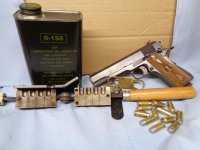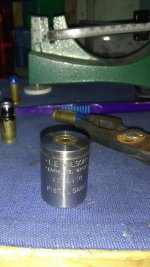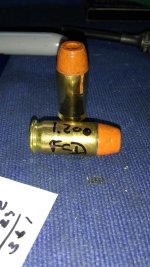So let me follow up with this and put a cap on the solution because don't we hate it when some nitwit starts a thread like this and never posts the fix? So, dear future reader with my exact problem, this post is for you.
As stated earlier, some barrels have no leade and one of them is mine (meaning the rifiling starts RIGHT at the chamber).
My powder coated bullets have flaws and lumps on some of the noses. Never a problem in numerous 9mm. But in this case, those little bumps were contacting the rifiling and causing some rounds to not go into battery.
I got my hands on some Lee TC-452-230 powder coated and some of the same in Hi-Tek. All nicely done with clean noses. A little smaller nose on these bullets. I was able to seat these into about 1.185 and they chambered and ran fine.
My 250 grain bullets are really a bit large, but I sorted some with clean noses and (see attached pic) cut a couple of small slots into a case and tinkered with it until the empty case would chamber and I could just start a bullet into it. The slots are to allow the bullet to move easily. Then I pushed it into the chamber until the case was flush with the barrel hood. Had to tap it out (like a squib). This gave me the max cartridge length to the lands of the rifiling, 1.242. I assembled another dummy round without the slots and started seating it. I really thought it would plunk test somewhere in the 12.30-ish range but had to get down to 1.205 before it would drop in and out of the chamber and give me that satisfying brass on steel sound when it bottoms out.
Which brings me to my last point - the case gauge is fine but doesn't have a barrel attached! All it tells you is that your CASE dimensions are in spec. The bullet can (and did) hit the lands causing a failure to go into battery. Use your barrel as a case gauge, as mentioned earlier in this thread.
The other solution, by the way, is to have someone ream the throat and the guy mentioned earlier in this thread is apparently the go-to guy for that. But, it's 60 to a hundred bucks and seemed (to me, anyway) that if the factory could build ammo that chambers, I should be able to as well. I'm happy I stuck with it.
So, I thank the numerous contributors to this thread. I never imagined, after the scads of 9mm I've loaded that 45ACP would be such a problem.









